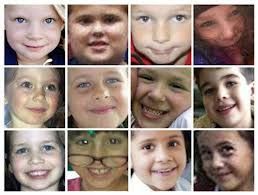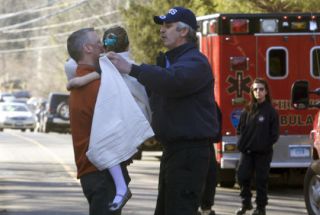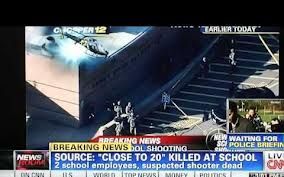
Law and Crime
Why No Photos of the Slaughtered Newtown Children?
Undisturbing crime scene photos won't melt resistance to gun control.
Posted December 20, 2012

Friday, December 14, 2012. My wife and I watched the Breaking News -- the nightmare, this time at a Connecticut Elementary school, the latest unspeakable horror involving children, guns, and yet another mad man, yelling his anger through the barrel of an assault weapon in a Niagara of bullets at little bodies.
I gulped and blinked my way through the photograph of a woman’s face in silent scream, then an adrenalized but incredulous TV reporter, the terse, ragged, comments of one parent, one heroic teacher, one self-numbing coroner running on fumes and grit, and one police chief. One after another their faces, their voices, their eyes, their body language spoke to the tragedy of the killing field.
The town’s collective trauma would be its legacy, its name joins a sad list of blind-sided communities that are now free-associated with their tragedies rather than their charms. As a viewer, I was transfixed, but I was still outside of the experience. The pictures informed but didn’t evoke. “Why?” I wondered.
Roaming channels for different takes, I came upon an emotionally fragile third grade teacher, Connie Sullivan. She was describing how she comforted her students and kept them safe as they huddled together barricaded in a locked classroom. Haltingly, she detailed how she helped them cope with the terrifying hallway and intercom sounds of children screaming and shots being fired.
I was not stunned, not whimpering, not sniffling, but I was unconsciously wiping away rivulets of tears flowing down my cheeks, obscuring my vision of Connie Sullivan in her painful struggle to hold back her own tears and shore up the cracks in her voice.

Her image: her pained smiles and closed eyes as she battled to form her words and obliterate her sense memories pushed me over the edge. I allowed the full force of this incomprehensible event to bridge the gaps between my brain and my heart.
But soon, too soon, the gap once again yawned open -- I returned to trying to intellectually understand what had happened in Sandy Hook Elementary. My emotions retreated into unobtrusive quietude, I was back in intellectualizing mode.
The slaughter of innocents at Sandy Hook Elementary quickly triggered the expected outcry by citizens and politicians for more effective gun control legislation and better funded mental health detection and treatment procedures.
This “riled up, ready to go” clamor and ritualized public posturing happens every time there is an eruption of mass murders. But this time, perhaps because of the age of the victims and the presumed safe location, a President, pundits, politicians, and pastors are calling this carnage the “tipping point.” The feeling is that the “tide may have shifted in favor of support for enhanced gun control legislation.”

Is that true? Has this obscene, perverted slaughter really moved the national debate to a tipping point? Are rules of the macabre legislative game of gun control really on the cusp of meaningful change? It’s questionable. I don’t think it can happen without a concerted, sustained devotion to change.
The battle over Second Amendment rights and freedoms is once again joined. Some even argue that these mass murders are the result of too few rather than too many guns. Armed self-defense is the antidote to armed criminals and mad men, they argue. “If only the school principal had been armed,” goes the right wing, narrow-channeled rant.
A picture is worth a thousand words -- and rouses passions that are necessary to do politically what has to be done—like get angry and direct that anger into constructive action.
The shock of Sandy Hook will wear off. Words will eventually stand in for deeds. At this writing the sale of guns has skyrocketed as gun aficionados begin another round of hoarding, just in case…
For most townspeople, except for those directly involved or connected to the Sandy Hook school, the balm of passing time allows passions to subside and energy for legislative activism fade, diluted by the demands of life’s routines. The families of the victims -- 20 children, six adults -- will try to find a way to adjust to the crack in their world. Some will firmly grip the torch of gun reform and political activism. Most won’t.
It could be different. Graphic images can counter inertial tendencies.
The American government intentionally discourages graphic coverage of dead soldiers even the arrival of their coffins. The footage is considered too upsetting. This reticence to look at the realities of death has spread throughout the mass media.

This policy grew out of TV news coverage of the Viet Nam War. Back then and today, it was generally believed that regardless of what LBJ was telling America, the unedited, graphic battle coverage of casualties and atrocities night after night on evening news turned millions of Americans against that war. A war really is hell, we were losing it, and what are we really fighting for?
Here’s the point: Pictures speak ideas that words alone are often incapable of evoking. Sometimes that’s good. Images of starving children in myriad African countries or of Haitian villages laid waste by hurricanes evoke more powerful charitable responses in viewers than do words alone.
Sometimes, it’s bad. Like now. Restrictions on powerful, disturbing images of carnage, like Sandy Hook, on the basis of social etiquette and careful compassion is information and sensory deprivation. This, in turn, can produce motivational deprivation.
A National Conversation
When is the proper time for the national conversation on gun control? Some say “wait a decent amount of time so emotional wounds can heal and grieving can run its proper course.”
I say: As soon as possible. Why? So that the anger and outrage over regulatory shortcomings can be harnessed and channeled effectively in a sustained fashion.
Where are the Visuals?
There were no photographs of any of the bodies of the twenty slaughtered children or six adults. Why? Good taste.
Good taste or bad idea? Bad idea, definitely. Rather than hide the effects of violence so as to not offend, we should move toward more tactically devised, realistic public exposure.
Aftermath images would stick in the minds and hearts of the public, refresh and renew the energy of the emotional drive needed to deal with potent, knee-jerk opponents to messing with the Second Amendment’s murky, mythic sanctuary for “the right to bear arms.”
If this means getting a family's permission to show the body of a slaughtered child, then that’s what should be done. "Bad taste" can make good sense when fighting for life-saving legislation.



